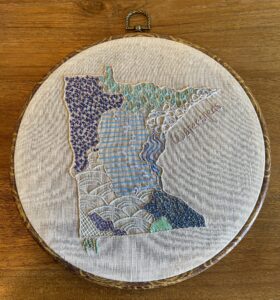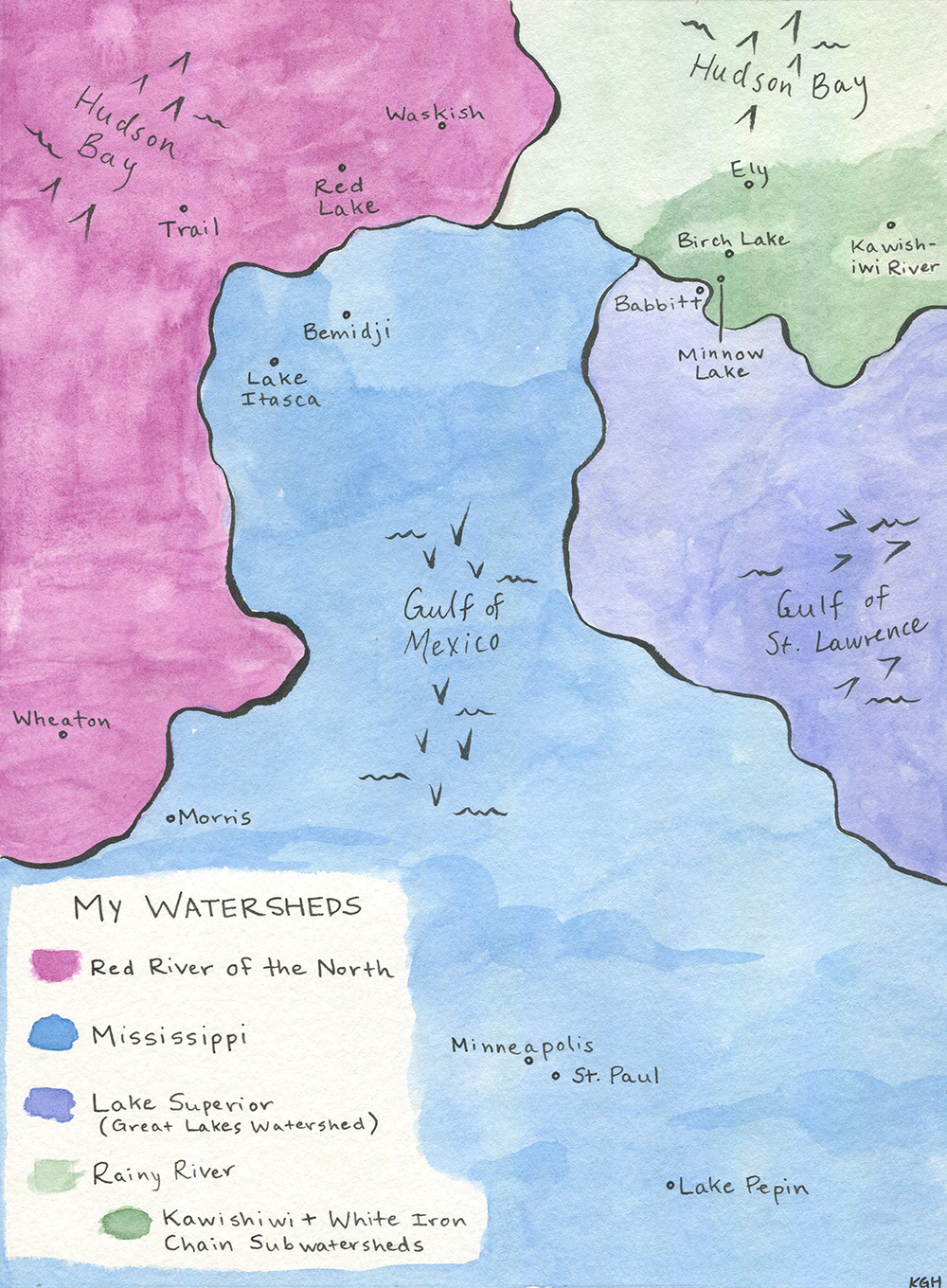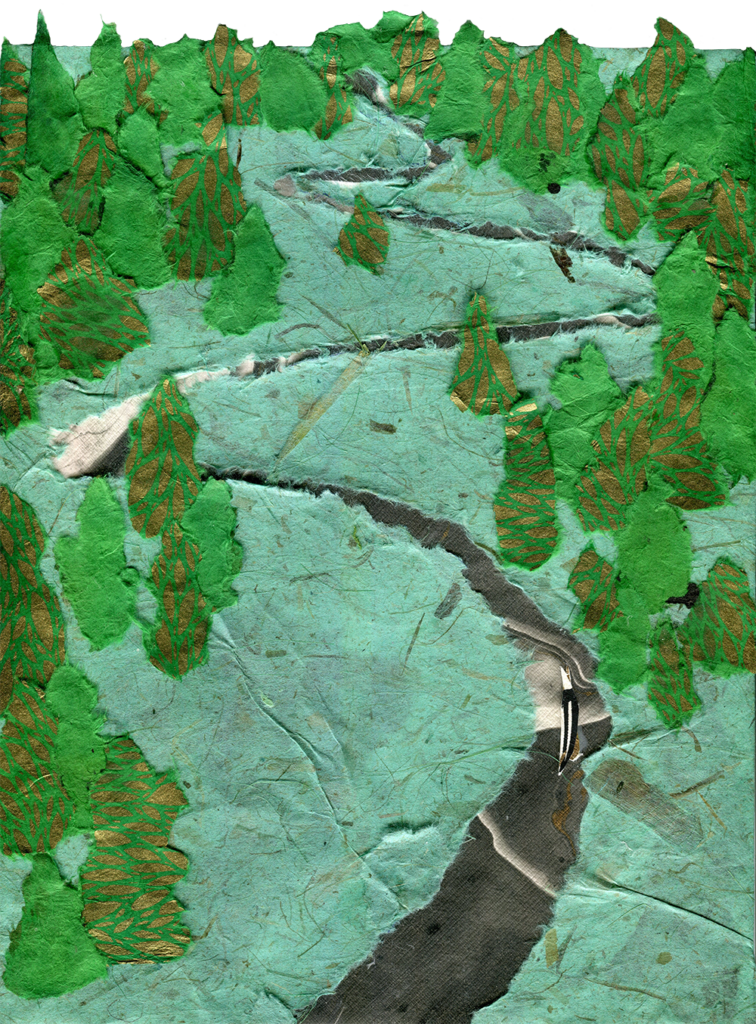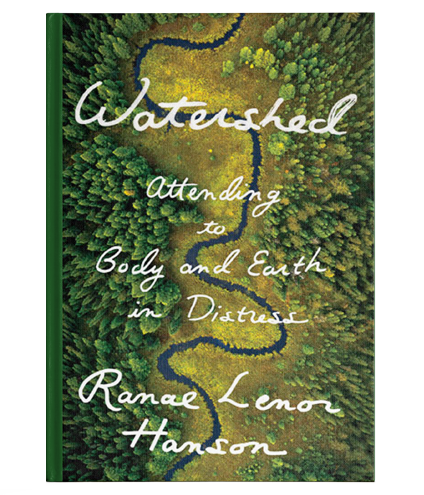Minnesota Watersheds in Embroidery

© 2021 Embroidery by Amelia Hanson
Minnesota Watersheds in Music
Watersheds
Click to listen to a “mini-geography lesson” by Dave Bostrom.
Find more of Dave’s music here.
Minnesota Watersheds in Watercolor

A map of Minnesota watersheds by Grace Harnois
Snake River Watershed in Torn Paper

Concept Art for Watershed by Amelia Hanson
Watersheds in Dance
“Force of Flows” – by Layla El-Khoury honors and educates about streams
Watersheds Honored by You . . .
What will you do to make art for the watershed that nourishes you?
Every area on earth that has biological life is fed by its own living watershed.
The word watershed can refer either to the ridge or swamp where water separates into different drainage systems,
or it can designate a region that is bounded by such a divide and from which water drains ultimately into a particular waterway or body of water.
Minnesota waters fan in three directions – the Mississippi flows south, Lake Superior flows east, and the White Iron Chain of Lakes and Red River of the North move to Hudson Bay.
In Minnesota and throughout the US, regions are divided into major watersheds and then into smaller watershed management areas.
Maps to Help You Explore
The map at this link – Map of Major US Watersheds – indicates the major systems.
This beautifully-colored map gives an idea of the smaller river systems that feed into the larger ones.
For drainage basins (watersheds) of the world, look here.
Also check this map from the Decolonial Atlas.
If you have a chance to teach about watersheds, consider using the lesson plan from The National Geographic Society.
Reviews for Watershed the book

“Traveling on the water taught me that, in a canoe, the best way to face a storm is head-on. Try to run from it and you won’t know what’s coming when the big waves hit. Get sideways to it and you’re sure to be swamped. Head-on, eyes open, you just might survive.”
The above quote describes the life of Ranae Lenor Hanson and is a metaphor for how we can address the current climate chaos. The book is part memoir of her body’s journey with type 1 diabetes and part exploration of the devastating effects of climate change on the body of Earth. She deftly weaves the stories so that we feel we are on the journey with her. Read full review >>
—Ruah Swennerfelt, Friends Journal
In her poignant memoir “Watershed”, Ranae Lenor Hanson points out that Minnesota is an apex whose rivers flow north to Hudson Bay, east through the Great Lakes, and south to the Gulf of Mexico. I rather enjoy the concept of our state being central to three directions. For me, it is a reminder that wherever you are in our state, there are three places you can flow. Read full review >>
—Mikki Morrissette, Minnesota Women’s Press
All water flows from one place to another. Water moves from high ground to low, through peat and sand, slowly cutting mighty stones into sediment. Then it changes form. Evaporates. Falling back to earth, water begins anew. Read full review >>
—Aaron Brown, Minnesota Brown: Modern Life in Northern Minnesota
In 2015, at age 64, Ranae Lenor Hanson developed an unquenchable thirst. There were other symptoms, too, but she chalked all of it up to stress. She had been intensely worried about global warming and the tepid response to it — from friends and colleagues, corporations and government. A good friend was convinced that if she would just lighten up, she’d feel better. Maybe so, she thought. Read full review >>
—Suzanne Swanson, Land Stewardship Project
Major Endorsements for Watershed
Born in northern Minnesota where waters divide, Ranae Hanson has been communicating with the earth with reverence and empathy since early childhood. Decades of conversations are gathered in Watershed, a beautifully written memoir that weaves together explorations of keenly observed impacts of ecologic damage, climate change, and personal illness. Wisdom that Ranae Hanson has gleaned from many years of service to the earth and her students is now available to us all. It is a captivating, cautionary tale urging humility, respect, and action.
—Ted Schettler, Science Director, Science and Environmental Health Network
In a direct and often wise voice, through a series of moving, revealing, and entertaining stories, Watershed makes clear the connection between climate change and our own bodies. A difficult task in a culture that ignores the urgency of climate change while denying that human beings are part of nature. Difficult, but needed now while the earth that sustains our bodies is under assault. This book presents us with a paradoxical gift, the idea that we can make use of the aches and pains and illnesses plaguing so many of us to wake up and act in common cause with the earth.
—Susan Griffin, author of Woman and Nature, A Chorus of Stones, and many other books
Ranae Hanson’s elegy for the Earth and our bodies speaks of the holy, the sacred. The fates of water, our bodies, our communities are intertwined. She gives voice to the voiceless. She reports on the sacred and challenges us to live our lives knowing that the connection to each other and the Earth is the basis for health, the holy, the sacred.
—Carolyn Raffensperger, Executive Director, Science & Environmental Health Network
Watershed is grounded and calming. It brings the full story of ecological disruption into view. Hanson’s life story combined with an exploration of the real threat and the embodied response that is necessary is a new and important angle to address climate change.
—Julia Nerbonne, Executive Director, Minnesota Interfaith Power and Light
Such a beautiful blend of Ranae’s own story and how it connects to the deeper story of environmental damage and climate change! The book gains gravitas and urgency by weaving the impact of environmental crisis on our own human bodies with stories from all over the globe. It shows that we must face this worldwide, systemic issue together now.
—Ann Manning, Director, Future First Initiatives
Ranae Hanson’s remarkable book is a deep, rich, profoundly personal and powerful exploration of how we are inseparable from the water that surrounds us, that flows through, around, and beneath our lives. It’s a book that connects us to where we stand, to the place, the watershed, the webs of love, water, family and nature that hold us throughout our lives. Its roots run deep, its implications even deeper, and it brings many rich gifts for these extraordinary times.
—Rob Hopkins, founder, Transition Movement
Whenever you are ready to face directly into the personal and global havoc that is climate chaos, you’ll want Watershed close at hand. This is a lovingly-compelling, strongly-illuminated primer for exploring the emotional terrain that awaits us once we accept the natural signs of dysregulation all around us. By relating her life experiences from a perspective of global interconnection, Ms. Hanson unflinchingly leads one into the profound, communal grief that awaits in the times ahead. Simultaneously she opens the reader, dimension by dimension, to the immeasurable love for all of life that underlies this vast experience of loss, and probably is untouchable without stepping through the ironclad gates of denial as she has done.
—Kaia Svien, MS. Facilitator of Joanna Macy’s Work That Reconnects, Meditation Instructor
This book took me away from this daily dose of gloom and filled me with a sense of preciousness enabling action that isn’t just reaction. Ranae Hanson’s personal and intimate stories are full of unsentimental love for people, trees, plants and animals displaced by our political and climate brutality. In the stories told here, those of us who are in true community with the world around, close by and far away, find moments of joy and solace by standing side-by-side near the trauma without averting our eyes. The stories point toward possible sustaining acceptance even in the midst of nightmare realities.
—Robert Bosnak, author of Embodiment and A Little Course in Dreams
The credo “water is life” has become a key environmental rallying cry in the years since Standing Rock, and this book helps us remember why. It recalls an American past, inhabits a global present, and imagines a working future—it will be an aid to many as they grapple with our difficult moment.
—Bill McKibben, founder of 350.org and author of Falter, The End of Nature, Deep Economy, and many other books